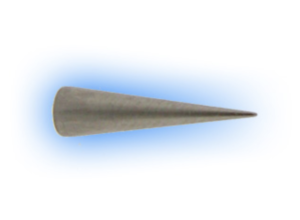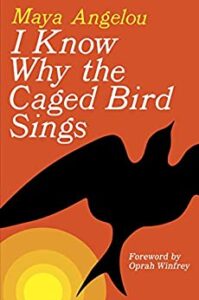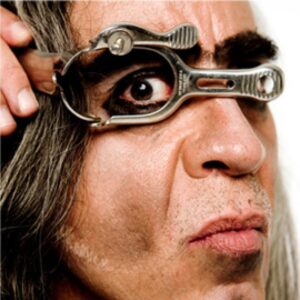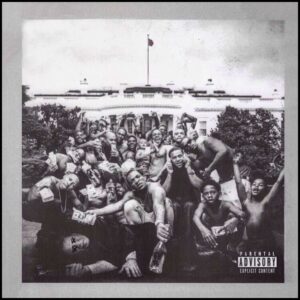For the 1st round of bibliography, I want to dedicate this to a performance piece I am brewing.
In Chinese mythology, there is a character name Xíng Tiān (刑天), who fought for Emperor Yan(炎帝)against Emperor Huang(黄帝). After failing, Emperor Huang hurried his head in Mountain Changyang(常羊山) to avoid its revival. However Xíng Tiān did not die, it transformed the nipples into two eyes, belly button as mouth. Xíng Tiān started to fight endlessly without its head, axes fell down without aims, the movement seem like a ridiculous and hilarious dance, it mused Emperor Huang and he spared its live. It was a tragedy indeed.

I have taken this “nipple as eye” facet and want to explore a facilitation that underlines the importance of re-creation through past traumas. Therefore, I decided to design a wearable spiky nipple that express my sound practices better in performing on stage.

Why spiky nipple? you might ask. That is a great question that I have only given a thought today: In order for re-creation to happen, a breakthrough of current blockage enabled by fear, isolation and self protection has to happen as well. Think of this layer of fear, isolation and self protection as a shield, and to break the shield I have chosen the spike as a spiritual “animal”, in which the spike is the spear. And the constant battle between the shield and the spear is a testament to the approach this breakthrough. And the performance with sound will manifest this act on stage.
And the pair of polarities such as the shield spear appear in daily life constantly, playing off the two provides a very vulnerable space mentally to connect with the observer, which is the audience.
Lets tune in to some performance artists that spoke of the same gravity:
PERFORMANCE ARTISTS:
1) In the work ‘Ever is Over All’ (1997), Pipilotti Risk smashed a car window with a flower, flower is commonly portrayed as “soft”, “innocent”, “colorful”; when car window is “hard”, “industrial”, “monochrome”. As she said I quoted:
“There is no rule for when and where I get my ideas – some are survival tactics, some are psychotic tics, some are very well thought over.”

I will be focusing on finding out the rule however in those psychological and subliminal deep dungeons, and link them to provoke this moment of breakthrough.
Now let’s jump back to inspirations again. There are many artists who have created art that deals with breaking through boundaries, over-exceedingly self-protection or emotional barriers, or, coping with trauma. Let’s see some examples:
2) Marina Abramović: Abramović is a Serbian performance artist who often explores themes of physical and emotional endurance in her work. In her 2010 performance piece “The Artist is Present,” she sat silently in a museum for 736 hours, inviting museum-goers to sit across from her and make eye contact. The piece was seen as a powerful exploration of vulnerability, human connection, and emotional endurance.

In this piece, what I found precious is the “staring”, eye to eye interactions are often very provocative in any kind of performance art. Because the audiences are coming to participate as “an observer”. Although many performances invite audience to join the process, it is never as direct as “artist is at present”, because the scale of the participants are so small (1 to 1), it magnified the experience of space and time with the artist.
3)Maya Angelou: Angelou was an American poet and author who wrote about her experiences as a black woman in America, as well as the trauma of childhood sexual abuse. Her most famous work, “I Know Why the Caged Bird Sings,” is a memoir that explores the themes of racism, trauma, and self-discovery.
“I know why the caged bird sings, ah me,
When his wing is bruised and his bosom sore,
When he beats his bars and would be free;
It is not a carol of joy or glee,
But a prayer that he sends from his heart’s deep core,
But a plea, that upward to Heaven he flings –
I know why the caged bird sings.”

4) Guillermo Gómez-Peña: Gómez-Peña is a Mexican-American performance artist who often explores themes of identity, immigration, and cultural trauma. In his work “El Mexorcist 3,” he explored the themes of the Mexican immigrant experience in the United States, using a mix of humor and horror to address the traumas of displacement and discrimination.

5) Joseph Beuys: Beuys was a German performance artist who explored themes of trauma and healing through his work. In “I Like America and America Likes Me,” he spent three days in a room with a live coyote, exploring themes of identity, trauma, and healing.

3) – 5) is a sequel of works from different artists I found resonance with:
people of color often shared some similarities of social oppression in this country, unfortunately. And to zoom in many industry, one like mine, had spoke so many ways of racism and tokenism into the music labels’ credential of choosing artists, in which the experience was so unpleasant and dehumanized for the art is not listened to but the identity demographic-tized. It seems to me most of times in metal music community, people are xenophobic and sinophobic and have a very confined way of accepting certain music coming their way, anything that does not look familiar or fit in a box could potentially loose any support. And at times I even feel like respect is a luxurious within circles of this creative community. Many stories to share, but I will stop here.
SOUND/MUSIC:
To finish my thesis, I would like to bring up the importance of the sound aspects of the process, which is the crucial to the performance and the construction of the wearable device. Here are some of the sound/musician artist I found related to topics I am adjusting.
1) Kendrick Lamar(let’s forget his more and more outrageous point of view on Twitter for a second plz) : Lamar is an American rapper who often incorporates themes of social justice, trauma, and personal growth in his music. His album “To Pimp a Butterfly” explores the complexities of the African-American experience, including the trauma of police brutality, racism, and the struggle to find meaning and purpose in life.

2) Yoko Ono – Yoko Ono is a pioneering sound artist and musician who has been exploring the boundaries of music and art for decades. Her work often deals with themes of peace, love, and healing.
3) Max Richter – Max Richter is a composer and musician who creates music that is often described as “neo-classical.” His work often deals with themes of memory, loss, and emotional healing.
4) Janelle Monáe – Janelle Monáe is a singer, songwriter, and actress who has been pushing the boundaries of pop music for over a decade. Her work often deals with themes of identity, gender, and social justice.
5) Karen Dalton was an American folk singer and musician who is known for her soulful and haunting voice. She was active in the 1960s and 1970s and is often associated with the Greenwich Village folk scene in New York City. Although Dalton never achieved commercial success during her lifetime, her work has had a significant impact on a number of contemporary musicians, including Joanna Newsom, Devendra Banhart, and Sharon Van Etten.
In terms of themes related to breaking boundaries, healing, and trauma, Dalton’s music often dealt with deeply personal and emotional subject matter. Her raw and powerful voice conveyed a sense of vulnerability and intimacy that spoke to the experiences of many listeners. Some of her most well-known songs, such as “Something on Your Mind” and “Katie Cruel,” deal with themes of heartbreak and emotional pain. Other songs, such as “In My Own Dream” and “How Did the Feeling Feel to You,” explore more abstract and introspective themes related to personal identity and self-discovery.
SONIC HEALING:
Sonic healing is the use of sound and music to promote physical, mental, and emotional well-being. It is based on the idea that sound can affect the body and mind in powerful ways, and that certain sounds and frequencies can be used to promote healing and relaxation.
There are many different forms of sonic healing, and they can be practiced in a variety of settings, from hospitals and wellness centers to private homes and meditation spaces. Some common techniques and practices include:
1) Sound baths – A sound bath is a group meditation experience that involves lying down and being bathed in a wash of sound, usually from various instruments such as singing bowls, gongs, and chimes.
2) Binaural beats – Binaural beats involve listening to two different frequencies in each ear, which can create a perceived third frequency in the brain. This can have a calming and meditative effect on the listener.
3) Music therapy – Music therapy is the use of music and sound in a therapeutic context to address a wide range of physical, mental, and emotional health concerns.
4) Chanting and mantra – Chanting and mantra involve using repetitive sound and vocalization to promote relaxation and a meditative state.
5) Tuning forks – Tuning forks are specialized instruments that produce specific frequencies when struck, and they can be used to promote relaxation and healing.
6) knowledge about 432khz and 440khz
Back in the days, musicians such as Bach, Beethoven, Mozart, Giuseppe Verdi, as well as a series of ancient musical instruments such as Tibetan Singing Bowl, West African string instrument Kora, Greek’s Lyre(7 string harp), Dutch Flute are customaed to be 432Hz. Until the era of Hitler, scientists studied and interpreted a theory that 440Hz was more likely to reach mind control effects. Paul Joseph Goebbels, the chief propagandist of the Nazi Party then re-standardized “A” to be 440Hz for musicians at the time in Germany; After World War II, the Rockefeller family devoted large funds to the American Federation of Musicians in order for them to change “A” to 440Hz as well. Later in 1953, International Organization for Standardization (ISO) did the same regulation. Since then “A” sets to be 440Hz has been a global standard. Based on the facts of these events, some might say it is just conspiracy theory, I would like to take a wild guess of it being a series of systematic deliberation and unsuccessful respect and inspection following on by different parties, mainly western parties in the world we live in and only can see.
And for the wearable device, I would like to zoom in an artist that I found very helpful to tap into the same magnesium my device will be doing with sound:
INTERACTIVE DEVICE/INTERFACE:
1) ‘The Whispers’ (2021) by Tarek Atoui, shared similar pair of these polarities.
Arek Atoui is a Lebanese sound artist and composer who has gained international recognition for his innovative and experimental work. He is known for his interdisciplinary approach, combining sound art, music, performance, and installation to create immersive and experiential works. Atoui’s work is widely recognized for its interdisciplinary and collaborative approach, which draws on a range of fields, from music and sound to architecture and design. His work challenges the traditional boundaries of these fields and encourages audiences to think differently about the role of sound in our lives.
References:
https://en.wikipedia.org/wiki/I_Like_America_and_America_Likes_Me
https://hemisphericinstitute.org/en/hidvl-collections/item/629-pocha-mexorcist.html
https://en.wikipedia.org/wiki/I_Know_Why_the_Caged_Bird_Sings
To Pimp A Butterfly – Kendrick Lamar ★★★★★
Marina Abramović: The Artist is Present







